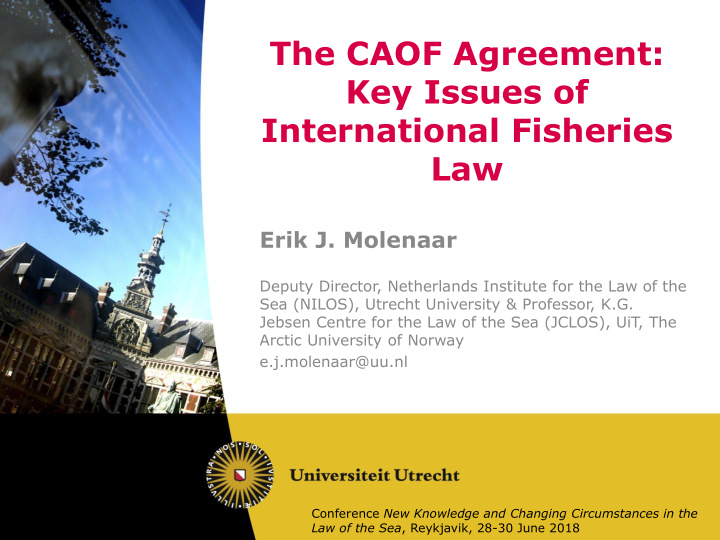



The CAOF Agreement: Key Issues of International Fisheries Law Erik J. Molenaar Deputy Director, Netherlands Institute for the Law of the Sea (NILOS), Utrecht University & Professor, K.G. Jebsen Centre for the Law of the Sea (JCLOS), UiT, The Arctic University of Norway e.j.molenaar@uu.nl Conference New Knowledge and Changing Circumstances in the Law of the Sea , Reykjavik, 28-30 June 2018
Overview presentation The Participants in the Five-plus-Five Process • A Unique Scenario • The Participants’ Interests • The Package Deal • Concluding Observations • 2
The Participants in the Five-plus- Five Process Not just the Arctic Five vs the Other Five • – Denmark on behalf of the Faroe Islands and Greenland (DFG): hybrid – 6 Arctic States (Arctic Five + Iceland) or: 6 Arctic Ocean coastal States – EU: acting in a de facto capacity of high seas fishing State, but also representing 3 Arctic States – China, EU, Japan and South Korea all have ( de facto ) Observer status with the Arctic Council 3
A Unique Scenario The Five-plus-Five had opportunity to determine the • conditions under which a future high seas fishery would be allowed to commence The Arctic Five had already seized this opportunity by • means of 2015 Oslo Declaration, which has two key elements – Geographical scope: only the high seas portion of the central Arctic Ocean – Qualified abstention from high seas fishing The Other Five agreed to use these two key elements as a • point of departure and these also ended up in CAOF Agreement 4
The Participants’ Interests These two key elements create a fundamental difference • between the central Arctic Ocean fisheries interests of the Arctic Five on the one hand, and the Other Five on the other In essence, the Other Five will be more inclined to favor • commencement of high seas fishing than the Arctic Five – Arctic Five only supportive of commencement if either they intend to participate in high seas fishing themselves, or if such fishing would not significantly conflict with their coastal State interests • utilization-oriented coastal State interests • conservation-oriented coastal State interests 5
The Participants’ Interests (cont.) Interests in the broader domains of international fisheries • law, the international law of the sea and the international law relating to the Arctic – Some of the Other Five had concerns on ‘multilateral creeping coastal State jurisdiction’ in the BBNJ Process & the Five-plus-Five process – Dissatisfaction of China, EU, Japan and South Korea with their inferior participatory status in the Arctic Council, the Arctic Council System & new, more peripheral Arctic bodies 6
The Package Deal All these interests of the participants eventually led to a • package deal on 4 components 1. decision-making; 2. the requirements for entry into force; 3. duration of the Agreement; and 4. recognition of the special responsibilities and interests of the Arctic Five in the central Arctic Ocean 7
Concluding observations The CAOF Agreement is in many ways a landmark • agreement – Application precautionary approach – Important step in gradual transformation of the freedom of the high seas The equality of the Five-plus-Five under the CAOF • Agreement only exists in form Optimal use of the CAOF Agreement’s full potential in • precautionary and ecosystem-based fisheries management 8
Thanks! Questions?
Recommend
More recommend